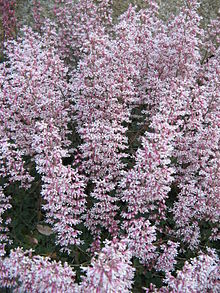- Heuchera
-
Heuchera 
Heuchera elegans in Mount Wilson (California) Scientific classification Kingdom: Plantae (unranked): Angiosperms (unranked): Eudicots (unranked): Core eudicots Order: Saxifragales Family: Saxifragaceae Genus: Heuchera
L.Species See text
The genus Heuchera (pronounced /ˈhjuːkɨrə/)[1] includes at least 50 species of herbaceous perennial plants in the family Saxifragaceae, all native to North America. Common names include alumroot and coral bells. They have palmately lobed leaves on long petioles, and a thick, woody rootstock. The genus was named after Johann Heinrich von Heucher (1677–1746), an 18th century German physician.
Alumroot species grow in varied habitats, so some species look quite different from one another, and have varying preferences regarding temperature, soil, and other natural factors. H. maxima is found on the Channel Islands of California, where it grows on rocky, windy, saline-washed ocean shores. H. sanguinea, called coral bells because of its terra cotta-colored flowers, can be found in the warm, dry canyons of Arizona. Gardeners and horticulturists have developed a multitude of hybrids between various Heuchera species. There is an extensive array of blossom sizes, shapes, and colors, foliage types, and geographic tolerances.
Contents
Food and medicinal uses
Though tangy and slightly astringent, the leaves may be used to liven up bland greens.
Natives of the Northwest U.S. have used tonic derived of Alumroot roots to aid digestive difficulties, but extractions from the root can also be used to stop minor bleeding, reduce inflammation, and otherwise shrink moist tissues after swelling.
Cultivation
The majority of Heuchera sold for gardens are hybrids of H. americana, such as 'Green Spice' (see illustration). [2] The original 'Purple palace' discovered in a Royal Palace in England is believed to be a H micrantha x H villosa hybrid, (New England Guide 2000) which was then crossed with H americana. A further group of hybrids arose from crossing Heuchera with Tiarella, to form Heucherella.
Selected species
- Heuchera abramsii - San Gabriel Alumroot
- Heuchera alba - White Alumroot
- Heuchera alpestris - San Bernardino Alumroot
- Heuchera americana - American Alumroot
- Heuchera brevistaminea - Laguna Mountain Alumroot
- Heuchera x brizoides - Coral Bells (Hybrids)
- Heuchera cespitosa - Tufted Alumroot
- Heuchera chlorantha - Green-flowered Alumroot
- Heuchera cylindrica - Roundleaf Alumroot, Lava Alumroot
- Heuchera duranii - Duran's Alumroot
- Heuchera elegans - Urnflower Alumroot
- Heuchera hirsutissima - Shaggy-haired Alumroot
- Heuchera maxima - Island Alumroot, Jill-of-the-Rocks
- Heuchera merriamii - Merriam's Alumroot
- Heuchera micrantha - Crevice Alumroot, Smallflower Alumroot
- Heuchera parishii - Mill Creek Alumroot
- Heuchera parvifolia - Small-flowered Alumroot
- Heuchera pilosissima - Seaside Alumroot, Parish's Alumroot
- Heuchera pulchella - Sandia Alumroot
- Heuchera rubescens - Pink Alumroot
- Heuchera sanguinea - Coral Bells
- Heuchera villosa - Hairy Alumroot, Maple-leaved Alumroot
- Heuchera wootonii - Wooton's Alumroot
Gallery
References
- ^ Sunset Western Garden Book, 1995:606–607
- ^ Armitage's Garden Perennials
External links
Categories:- Heuchera
- Flora of California
- Saxifragales stubs
Wikimedia Foundation. 2010.



